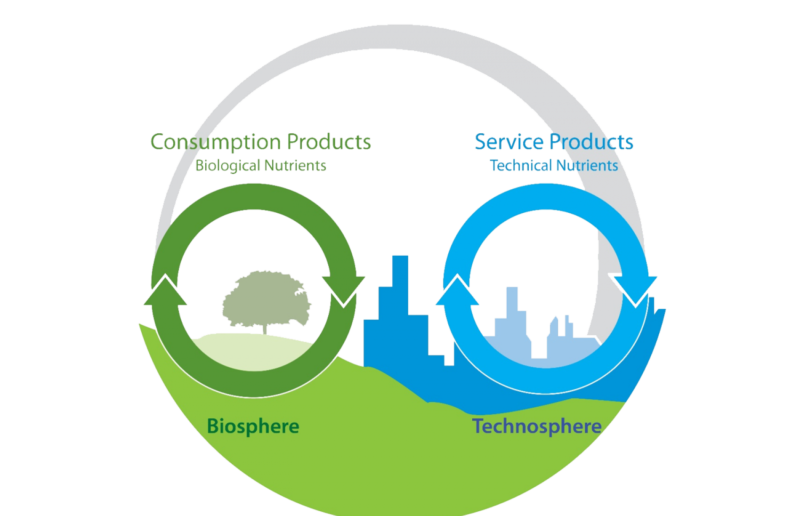Cradle to Cradle is a design and manufacturing philosophy that emphasizes sustainability and the circular economy. It was first introduced by William McDonough and Michael Braungart in their book “Cradle to Cradle: Remaking the Way We Make Things.” The main idea behind Cradle to Cradle is to design products and systems in such a way that they can be disassembled and reused, rather than ending up as waste. In other words, it’s a holistic approach to design that considers the entire lifecycle of a product, from the raw materials used to create it, to its end of life and beyond.
The Five Principles of Cradle to Cradle Design
The Cradle to Cradle philosophy is based on five core principles:
- Material health: Choose materials that are safe for humans and the environment.
- Material reutilization: Design products and systems that can be disassembled and reused.
- Renewable energy: Use renewable energy sources to power manufacturing processes.
- Water stewardship: Manage water usage and quality responsibly.
- Social fairness: Treat workers and communities fairly and with respect.
Benefits of Cradle to Cradle Design
There are several benefits to adopting a Cradle to Cradle approach to design and manufacturing. First and foremost, it’s better for the environment. By designing products that can be disassembled and reused, we can reduce waste and minimize our impact on the planet. Additionally, Cradle to Cradle design can also lead to cost savings, as companies can reuse materials and components, rather than having to purchase new ones. Finally, Cradle to Cradle design can also lead to greater innovation, as companies are forced to think outside the box and come up with new ways of doing things.
Examples of Cradle to Cradle Design
There are several companies and products that have embraced the Cradle to Cradle philosophy. For example, Shaw Industries, a leading carpet manufacturer, has adopted Cradle to Cradle principles in the design and manufacturing of its carpets. The company uses safe and healthy materials, designs carpets that can be easily disassembled and recycled, and powers its manufacturing processes with renewable energy. Similarly, Herman Miller, a leading furniture manufacturer, has also embraced Cradle to Cradle design. The company uses sustainable materials, designs furniture that can be disassembled and reused, and strives to minimize its environmental impact.
Conclusion: The Future of Cradle to Cradle Design
Cradle to Cradle design is a powerful and innovative approach to design and manufacturing that has the potential to revolutionize the way we make and use products. By embracing the principles of Cradle to Cradle design, companies can create products that are better for the environment, more cost-effective, and more innovative. As more and more companies adopt this philosophy, we can look forward to a future where waste is minimized and sustainability is prioritized.
Similar Topics
FAQs about Cradle to Cradle
1. What is Cradle to Cradle?
Cradle to Cradle is a design and manufacturing philosophy that emphasizes sustainability and the circular economy. It was introduced by William McDonough and Michael Braungart in their book “Cradle to Cradle: Remaking the Way We Make Things.” The philosophy is based on the idea of designing products and systems in such a way that they can be disassembled and reused, rather than ending up as waste.
2. What are the principles of Cradle to Cradle design?
The Cradle to Cradle philosophy is based on five core principles:
- Material health: Choose materials that are safe for humans and the environment.
- Material reutilization: Design products and systems that can be disassembled and reused.
- Renewable energy: Use renewable energy sources to power manufacturing processes.
- Water stewardship: Manage water usage and quality responsibly.
- Social fairness: Treat workers and communities fairly and with respect.
3. What are the benefits of Cradle to Cradle design?
There are several benefits to adopting a Cradle to Cradle approach to design and manufacturing, including:
- Reduced environmental impact: By designing products that can be disassembled and reused, we can reduce waste and minimize our impact on the planet.
- Cost savings: Companies can reuse materials and components, rather than having to purchase new ones.
- Increased innovation: Companies are forced to think outside the box and come up with new ways of doing things.
4. Are there any examples of companies that have adopted Cradle to Cradle design?
Yes, there are several companies and products that have embraced the Cradle to Cradle philosophy. For example, Shaw Industries, a leading carpet manufacturer, has adopted Cradle to Cradle principles in the design and manufacturing of its carpets. Herman Miller, a leading furniture manufacturer, has also embraced Cradle to Cradle design in its products.
5. What is the future of Cradle to Cradle design?
Cradle to Cradle design has the potential to revolutionize the way we make and use products. As more and more companies adopt this philosophy, we can look forward to a future where waste is minimized and sustainability is prioritized.










